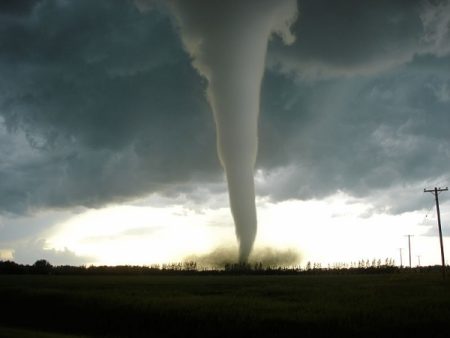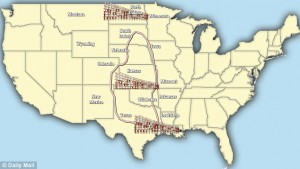June 27, 2014 – A Temple University physicist has proposed a plan to build a series of 300-meter-high (1,000 foot) walls across parts of the American Midwest to inhibit tornado activity. These “Great Walls of America” would be placed in North Dakota, Oklahoma, and South Texas near the Louisiana border.
The proposal appears in the current issue of the International Journal of Modern Physics. The author of the paper, Rongjia Tao, believes the walls would act as air dams to break up airflow responsible for seeding the thunderstorms that turn into super-cells, the spawners of tornadoes.
Meteorologists are highly skeptical pointing out that the Midwest already has elevated areas like the Ozarks in Arkansas and the Wichitas in Southwestern Oklahoma. They indicate that neither of these two natural physical rises appear to inhibit super-cells from forming in their areas of Tornado Alley.
Tornado Alley is the name meteorologists have given to an area from the Appalachian Mountains in the east to the Rocky Mountains in the west. It pretty much covers the entire Mississippi-Missouri-Ohio River valley system and the surrounding Great Plains. In 2013 this region recorded the bulk of the 813 total tornadoes reported in the United States that year.
Why do tornadoes happen here more than anywhere else? Because the topography and geography provide a perfect battle ground for cold and warm air fronts. When they confront each other they spawn these super-cells that generate tornadoes about 30% of the time.
Tao looked at the topography of the Northern and Eastern China Plain and the similar air masses that can be found there. He noted that they don’t spawn tornadoes at nearly the same frequency as Tornado Alley. His hypothesis argues that the geography of these areas in China contain a series of east-west ridges and mountain ranges that sufficiently dampen the turbidity of similar air masses to those found in Tornado Alley. But in China the thunderstorms seldom become super-cells. His proposed solution, therefore, is to simulate those mountain ridges by strategically placing walls in the path of the winds to lessen their turbidity. Initially he proposes three in the areas I mentioned above. After statistical verification validating his theory he then recommends the walls be extended in length over time.
But Tornado Alley isn’t the only place where tornadoes happen in North America. Four struck in Southern Ontario in the last week, all just north and west of Toronto. And although meteorologists claim that tornadoes are not spreading geographically in North America in response to atmospheric warming, they are admitting to an increase in intensity. For those who believe the area of tornado activity is widening, meteorologists respond with the following.
In the case of Toronto which has grown dramatically in size over the last 50 years, the growing urban population has moved into what was formerly rural areas. These are areas where funnel clouds have probably touched down numerous times in the past only to be seen by farmers and cattle. But now when they touch down they wreak havoc in new subdivisions, ripping off roofs and tossing vehicles.
In an article appearing in May of 2013 in Scientific American, climate scientist, Kevin Trenberth of the National Center for Atmospheric Research, Boulder, Colorado, argues that the climate change impact on an already unstable area like Tornado Alley is “probably only 5 to 10% in terms of the instability and subsequent rainfall.” He goes to state that this “translates into up to a 33% effect in terms of damage.” But what he is describing is air masses, not super-cells. He states that “a tornado is largely chance weather.”
Tao is a physicist, not a climate scientist. It is an interesting hypothesis but to build his walls the cost will be significant. And should one be struck by a wind event such as a tornado, and should it fall, the damage could be catastrophic.













